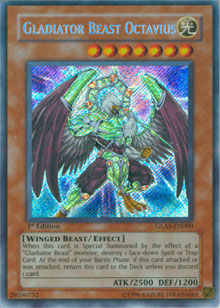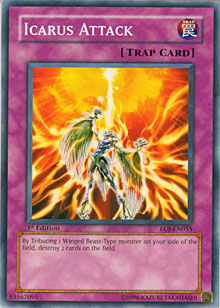Some of the best cards in the game often turn out to be ones that have been ignored for months, perhaps even years. Phoenix Wing Wind Blast saw little to no serious play until its format-defining showing at Shonen Jump Championship Washington one year ago. Cold Wave had been around for ages and had  seen next to no use until it became an explosive addition to Gladiator Beasts. Compulsory Evacuation Device is another example of an old card that was never originally played much, only to make Day 2 finishes years later.
seen next to no use until it became an explosive addition to Gladiator Beasts. Compulsory Evacuation Device is another example of an old card that was never originally played much, only to make Day 2 finishes years later.
After writing about Lightsworn Sabre last week I’m eager to discuss another hidden gem, and with just one week to go before we start our preview articles for Crossroads of Chaos, today is my last chance to do it. Let’s get janky!
Ever since Shonen Jump Baltimore, a lot of us here at Metagame.com have been looking at new options for Gladiator Beasts. I’ve written tech articles about the deck’s possible plays, Jerome’s emphasized the strength of cards like D.D. Crow, and Matt Peddle’s gone in-depth with some of the deck’s trap possibilities. We even brought in Shonen Jump Champion Michael Kohanim to share his take on the deck’s future, and the result has been discussions of everything from Compulsory Evacuation Device and The Transmigration Prophecy, to Jutte Fighter and the elimination of Elemental Hero Prisma.
But there’s one option that we haven’t said a word about, and today I want to give it its due: Gladiator Beast Octavius might finally be fit for tournament play. Why? Well to start . . .
. . . He’s Big. Really, Really Big
If we’re going to investigate Octavius as an option for serious competitive play, we need to start with his number-one asset: his size. With 2500 ATK, terms like "ginormous," "gargantuan," and "whoa Nelly, that’s a big Gladiator Beast!" are all fair descriptors. Size isn’t everything in the Yu-Gi-Oh! TCG, but in the case of Gladiators it happens to be pretty close. Octavius’s huge ATK power brings more to the table than 2500 damage a turn.
First up, that size makes it very easy to control the field—in the TeleDAD matchup, nothing short of a Synchro or Dark Armed Dragon is going to take Octavius down, and that means you’ll have an easy time maintaining field presence to use Gladiator Beast War Chariot.
More than that, the number-one Synchro your opponent normally wants to summon when they face Gladiator Beasts is the one that can’t attack over Octavius: Stardust Dragon. Octavius’s potential to trade with Stardust in battle is awesome, and the only challenge in doing so is working around Octavius's mandatory effect - often as easy as not setting a spell or trap yourself. If the destruction effect can't be worked around but your opponent's got a potential target, then it's the perfect chance to play Gladiator Beast War Chariot: you'll lure out Stardust's effect and then negate it while blowing away one of your opponent's face-down cards. If your opponent doesn't have another counter trap to play in response, your counter trap will elevate the spell speed of the chain and keep your opponent from using the card Octavius's effect targeted. If your opponent needed to spend two cards to get Stardust to the field in the first place (say, by activating Monster Reborn on Caius the Shadow Monarch or Destiny Hero - Malicious to gather Synchro material), the blow is even more substantial.
Naturally, when Octavius attacks and trades with Stardust it goes to the graveyard, meaning two things. First, you won’t need to pay that ridiculous discard cost to keep it around, since it’s already gone. Second, once Octavius is in the graveyard you can bring it back with Gladiator Beast Darius. Darius and Octavius wield 4200 ATK together, and since Darius will negate Octavius’s effect you’ll dodge potential interference from Stardust, while again dodging the discard. You’ll notice that a lot of my tips for using this card will revolve around ways to circumvent that discard.
Remember, the discard effect only kicks in on your turn, and only if Octavius actually participated in a battle. If all you need is a wall to keep your defenses up and make War Chariot a live play, you can just leave Octavius hanging out and not doing anything. It’s another way to keep a Gladiator on the field so you can go for a contact Fusion on the following turn, too. But if your trigger finger is truly itchy, you can always attack, discard a Gladiator Beast card, and then bring that card back to your hand with Gladiator Beast Equeste too. It’s yet another great trick that wasn’t possible back when Octavius was released.
If you ever have the misfortune to draw Octavius or have it sent back to your hand, remember that you can discard it for something like Phoenix Wing Wind Blast and use it in a contact Fusion with Darius later to get it back into your deck. Heck, Octavius’s own discard effect is a handy way to get Bestiari or Laquari to your graveyard too, making contact Fusions a little easier. There are synergies wrapped in synergies here, and it’s largely due to cards that weren’t on offer back when Octavius was first labeled unplayable.
In Fact, There Are a Lot More Combos Where Those Came From
Branching out beyond the cards you’d expect to see in your average competitive Gladiator Beast build, we can find a number of innovative choices that work with Gladiator Beast Octavius. The first and most obvious is a card duelists have experimented with since Gladiator’s Assault, but that never quite reached viability.
That card is Icarus Attack. Gladiator Beast Bestiari and Gladiator Beast Octavius are both Winged Beast monsters, making them valid tributes for the two-for-two trap card. The problem is that initially, there was no reason to run more than two copies of Bestiari, and little to no reason to run Octavius. The rest of the Gladiator Beasts weren’t compatible with Icarus Attack, and that left few opportunities to use it. But Gladiator Beast Equeste finds yet another synergy here, being a Winged Beast itself. With three copies of Bestiari, two copies of Equeste, and one or two copies of Octavius, you’d have plenty of Winged  Beasts to go around plus a means of retrieving them once you tribute them off. Preempting a Synchro summon of Malicious and Krebons by just blowing both monsters away can be a game-winning play, and even if Icarus Attack and the Winged Beasts "cost" you real card presence while your opponent’s Malicious is sort of free, Equeste’s effect makes up for that problem. Icarus Attack is a great call in general right now, because it simplifies the field against TeleDAD. That gives Gladiator Beast Laquari a big opportunity to command the pace of play with its high ATK, while making it easier to press through a contact Fusion by destroying copies of Solemn Judgment before you Fuse.
Beasts to go around plus a means of retrieving them once you tribute them off. Preempting a Synchro summon of Malicious and Krebons by just blowing both monsters away can be a game-winning play, and even if Icarus Attack and the Winged Beasts "cost" you real card presence while your opponent’s Malicious is sort of free, Equeste’s effect makes up for that problem. Icarus Attack is a great call in general right now, because it simplifies the field against TeleDAD. That gives Gladiator Beast Laquari a big opportunity to command the pace of play with its high ATK, while making it easier to press through a contact Fusion by destroying copies of Solemn Judgment before you Fuse.
Gladiator Beast’s Respite has also become more viable with the recent trend of running more Gladiator monsters. If you haven’t seen this spell card in a while, it lets you shuffle back two "Gladiator Beast" cards from your hand to your deck, then replaces the three cards you’ve lost by letting you draw three more. It thins your deck by a single card (the Respite itself) and gives you more chances to draw key cards like Gladiator Beast War Chariot and Test Tiger, which are often hard to search (and crushing when played in multiples). War Chariot and even a second Respite can also be shuffled back since they count as "Gladiator Beast" cards, and that dose of speed and filtering may be what’s needed for Gladiators to remain competitive.
For our purposes though, Respite is the best thing going when you’re stuck with a copy of Octavius in hand. Shuffle it back, get another card, and you can tag it back in later. This is important, because there’s little else to do with Octavius should it wind up in your hand. I’m not currently a fan of any discard-costed effects in the deck, and though I mentioned Phoenix Wing Wind Blast earlier, the popularity of that card seems to be dwindling in this particular archetype.
If your opponent is playing Skill Drain then Octavius can be very good when summoned early. Skill Drain will negate Octavius’s discard effect, meaning you’ll have a good chance of summoning a vanilla 2500 ATK monster for free. You’ll have to be quick, but this premise happens to transfer over to a proactive strategy you can control.
Lightsworn have always been a tough matchup for Gladiator Beasts, and modern competition is no exception. However, Light-Imprisoning Mirror remains a great tech pick in the matchup, and if you play Gladiator Beast Octavius you’ll reap an extra benefit. The Mirror will negate Octavius’s discard effect since it’s a Light monster. Nothing in the conventional Lightsworn lineup short of Judgment Dragon can take Octavius down when the Mirror’s on the field, so you buy yourself precious time while hammering out a ton of damage and ensuring that you keep control of the game.
There’s a lot to reconsider about Gladiator Beast Octavius now that dueling has changed so drastically. The popularity of Solemn Judgment means that Octavius’s effect will have at least three optimal targets in just about any matchup. Chaining Phoenix Wing Wind Blast to Octavius’s effect is often very poor, and the proliferation of non-chainable traps like Dimensional Prison and Mirror Force is another vote in Octavius’s favor. Gladiator Beast Equeste makes Octavius’s cost more manageable, and its sheer size is far more valuable than it once was.
We’ve talked a lot about innovations to the Hero builds of Gladiator Beasts as well as the non-Hero equivalents, but I think there’s a viable Winged Beast variant here too. Gladiator Beast Octavius is an essential part of that puzzle, so give it a try yourself. You’re going to be surprised at what this oft-maligned monster can accomplish in modern metagames.
—Jason Grabher-Meyer